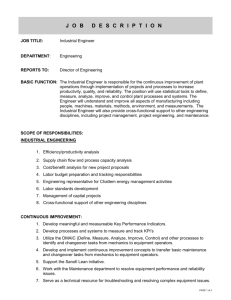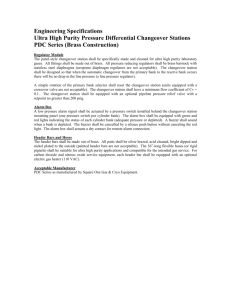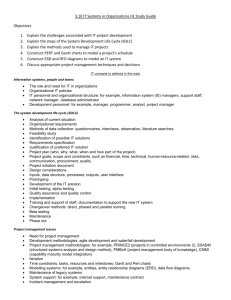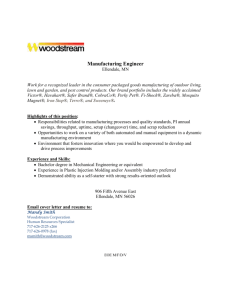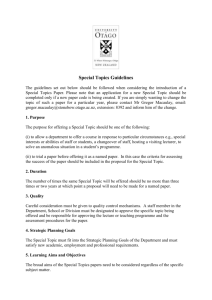A Safe Chemical-Oxygen Self-Rescuer Changeover in Adverse
advertisement
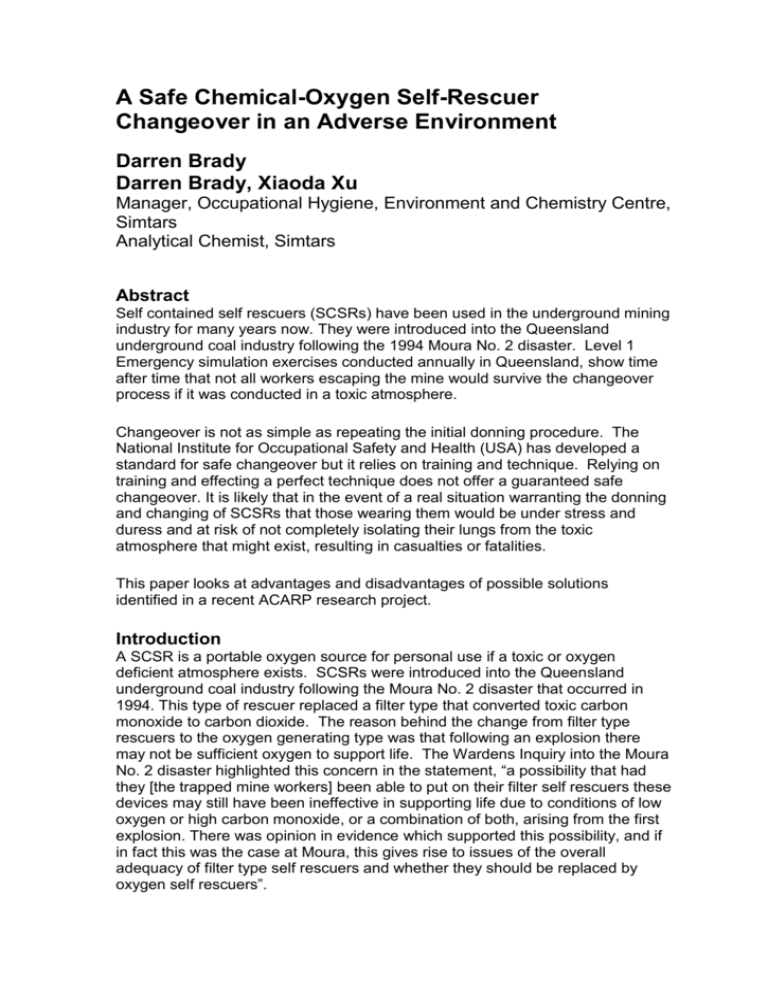
A Safe Chemical-Oxygen Self-Rescuer Changeover in an Adverse Environment Darren Brady Darren Brady, Xiaoda Xu Manager, Occupational Hygiene, Environment and Chemistry Centre, Simtars Analytical Chemist, Simtars Abstract Self contained self rescuers (SCSRs) have been used in the underground mining industry for many years now. They were introduced into the Queensland underground coal industry following the 1994 Moura No. 2 disaster. Level 1 Emergency simulation exercises conducted annually in Queensland, show time after time that not all workers escaping the mine would survive the changeover process if it was conducted in a toxic atmosphere. Changeover is not as simple as repeating the initial donning procedure. The National Institute for Occupational Safety and Health (USA) has developed a standard for safe changeover but it relies on training and technique. Relying on training and effecting a perfect technique does not offer a guaranteed safe changeover. It is likely that in the event of a real situation warranting the donning and changing of SCSRs that those wearing them would be under stress and duress and at risk of not completely isolating their lungs from the toxic atmosphere that might exist, resulting in casualties or fatalities. This paper looks at advantages and disadvantages of possible solutions identified in a recent ACARP research project. Introduction A SCSR is a portable oxygen source for personal use if a toxic or oxygen deficient atmosphere exists. SCSRs were introduced into the Queensland underground coal industry following the Moura No. 2 disaster that occurred in 1994. This type of rescuer replaced a filter type that converted toxic carbon monoxide to carbon dioxide. The reason behind the change from filter type rescuers to the oxygen generating type was that following an explosion there may not be sufficient oxygen to support life. The Wardens Inquiry into the Moura No. 2 disaster highlighted this concern in the statement, “a possibility that had they [the trapped mine workers] been able to put on their filter self rescuers these devices may still have been ineffective in supporting life due to conditions of low oxygen or high carbon monoxide, or a combination of both, arising from the first explosion. There was opinion in evidence which supported this possibility, and if in fact this was the case at Moura, this gives rise to issues of the overall adequacy of filter type self rescuers and whether they should be replaced by oxygen self rescuers”. Although removing the problem associated with the filter type rescuers and a lack of oxygen, the SCSR introduced a new problem. As there is a limit to the amount of oxygen that each unit can generate, it is unlikely that the belt worn unit would provide sufficient oxygen to enable escape from the mine. This means that additional units (with a longer duration) or compressed air breathing apparatus (CABA) need to be strategically positioned around the mine and units in use swapped with them before being exhausted. It is quite possible that up to five changeovers could be required for a mine worker to exit a mine. Level 1 Emergency simulation exercises conducted annually in Queensland have regularly shown that not all underground personnel are proficient in the changeover process. During Level 1 exercises a fragrance is sprayed in the air during the changeover process so that those changing rescuers get an indication of the success of their changeover. Some personnel have reported that they noticed the smell or tasted the spray during the process. Video footage of the changeover process is also reviewed and problems with the process are often easily identified. If these changeovers had occurred in a toxic atmosphere (the situation the SCSRs are designed for use in) it is probable that there would be casualties or fatalities. Currently most mines rely only on training and perfect execution to ensure that safe changeovers occur. This leaves no room for error when changeovers are executed in toxic atmospheres, again the exact situation the SCSRs were designed for and likely to be present if there was a need to don the unit in the first place. It would be an avoidable tragedy for a fatality to occur purely from a poor changeover. In search of a solution to this potential problem Simtars undertook a project to investigate options that would provide an easily relocatable “fool proof” solution that would provide a respirable atmosphere to effect the changeover regardless of the mine atmosphere. With funding assistance from ACARP (the Australian Coal Association Research Program), the project was aimed at providing underground mines with sufficient information on techniques readily available or easily adaptable, to ensure that changeovers are done without risk to underground personnel despite the toxicity of the underground environment. Discussion Before solutions could be identified, the requirements for a guaranteed safe changeover needed to be determined. Several sources were utilised to collect this information. Questionnaires were sent to mine sites with 32 completed questionnaires returned for review. The aim of the questionnaire was to determine what those that actually carry SCSRs, train in their use, and may be in the situation where they need to perform a changeover, see as the requirements of a guaranteed safe changeover. It also aimed to highlight problems they saw with the changeover process. In addition to the questionnaire, literature was reviewed, discussions conducted with industry personnel and consultation undertaken with the US National Institute for Occupational Safety and Health (NIOSH) personnel directly involved in testing and developing training programs for mine workers in the use and changeover of SCSRs. Further consultation was undertaken with personnel from the US National Personal Protective Technology Laboratory who had been directly involved in the development of SCSR products with a particular focus on changeovers. The responses to the questionnaires were varied, with some respondents indicating that training alone would be sufficient and others identifying a guaranteed respirable atmosphere as being most important. With problems that have been identified in level one exercises and elsewhere, a guaranteed atmosphere is definitely the number one requirement; training alone will not guarantee a safe changeover. This by no means suggests that appropriate training (including refresher training) is not a crucial component of safe self rescuer changeover. It is most likely that changeovers will take place at the cache. This is evident in a lot of the responses received and there was a strong emphasis on the need for this from the experts at NIOSH. A major advantage with this approach is any problems with the replacement unit can readily be addressed by replacing it with another unit. This is only possible at the cache. Therefore, any physical solution or solutions identified need to be positioned at every cache and need only be as portable as the cache. Responses received varied greatly in the time workers believed they could effect a changeover. Some were as low as 30 seconds and others were up to 5 minutes. Not all respondents had actually tested the time it would take them to changeover. Any proposed solution would need to be able to accommodate for changeovers taking this long. A summary of the identified requirements for a safe changeover are listed below; Essential Sufficient supply of respirable atmosphere for time taken for changeover of all units in the cache (as a minimum). Must be able to withstand and remain operational following any event that would necessitate the use of a SCSR. Must be easy to use. “Solution” must be useable at cache. “Solution” must be relocatable with cache. “Solution” must be low maintenance “Solution” must be readily identifiable as being in a serviceable state. Operation must be independent of mine services (such as mine wide compressed air). There is no certainty that these will remain operational following an event that would necessitate the use of a SCSR. If not already erected/established, must be easy and quick to establish including in low visibility. Effective training program developed prior to implementation with ongoing training and practice including in limited visibility. Low cost. Desirable Guaranteed visibility. Gas monitoring with local readout. Another issue identified by questionnaire respondents was that difficulty in breathing through a SCSR was an indicator of a problem with the unit. It is essential that all wearers of SCSRs are aware of the resistance to breathing that will be experienced when worn to differentiate between normal operation and a defective unit. Several of the respondents indicated that they would be changing from an SCSR to a CABA unit and ,although using CABA eliminates the need for any further changeovers, some of the same issues exist with the changeover (as seen in recent Level 1 exercises), hence any solution that could be used with CABA would be advantageous. An issue that was subsequently identified was the need for rehydration in the event of escape from a mine on foot. It is possible that six kilometres may have to be walked to escape the mine. Rehydration while wearing SCSRs during this time would be impossible if provisions were not made during the changeover process. The inability to rehydrate during this time under physical exertion would add to the stress and duress of the wearer. Options Some of the possible solutions include: dockable SCSRs, hybrid SCSRs, rigid changeover stations, inflatable changeover stations, refuge chambers, compressed air supplies and personal changeover suits. It is quite possible that for an effective solution a combination of these devices are required. Refuge chamber: Refuge chambers are already available to the industry. Although not specifically designed for the purpose of changeover they could offer a guaranteed safe environment for changeover to occur. For this purpose it is not intended that underground personnel remain in the chamber for any length of time, rather that they just use it essentially as a walk through fresh air base enabling a guaranteed safe changeover. Any such unit would need to be independent of general mine services for the provision of fresh air, and the units already available have provisions for this in place. There are additional advantages that a station like this offers. There is the opportunity for voice communications with the surface, in the guaranteed fresh air atmosphere, otherwise impossible when wearing a SCSR. It is possible for a crew to discuss the situation and their escape plan whilst in the refuge station. Rehydration is possible while in the guaranteed atmosphere. Such a structure can easily be set up to facilitate changeover to CABA. Obvious disadvantages of using refuge chambers throughout the mine at each cache are cost and ease of relocation with cache. There may be issues with installation and positioning of new units keeping up with fast pace development panels. There are two main types of refuge chambers available, rigid (Figure 1) and inflatable (Figure 2). Rigid refuge chambers are pre-made, with a rigid shell, and are designed to resist overpressures caused by explosions. Inflatable refuge stations are stored in a rigid skid (Figure 2), which is easier to relocate than a rigid chamber due to its size. When required the chamber is activated and inflates (Figure 3). The disadvantage is that the chamber needs to be deployed and is not available for immediate use. Figure 1: Rigid steel refuge chamber (Image courtesy of Strata Product) The chamber achieves a safe atmosphere using a combination of compressed air cylinders located inside the chamber and removing the carbon dioxide from the recirculated air within the chamber using carbon dioxide scrubbers. The option of relying on mine service compressed air is not recommended due to the vulnerability of supply in a mine disaster. Figure 2: Stored Inflatable Refuge Chamber Figure 3: Inflatable Refuge Chamber Deployed (Images courtesy of Strata Product) Changeover chamber: Changeover chambers (Figure 4) are similar to refuge chambers except they are not designed to be occupied for extended periods of time, they are only there to provide a guaranteed safe atmosphere. It is designed for a walk through situation. The unit has an airlock entry and exit which allows workers to walk in and out without ingress of contaminated air. Changeover chambers are also currently available for purchase by industry. Figure 4: Changeover Station Design (Picture courtesy of Strata Safety Product) Dockable SCSR: A new design for SCSRs is being developed that will eliminate the need to exchange mouth pieces when changing an expired SCSR. The concept is to be able to “dock” a fresh canister and then divert to it rather than the canister currently in use. This means that after initial donning the wearer does not have to be exposed to any toxic environment during escape from the mine. The design eliminates exposure to the external environment removing the riskiest process of the changeover. The prototype is still under final stages of testing and certification and, as yet, is unavailable for purchase. Figure 1: Illustration of dockable SCSR changeover (Picture courtesy of TPM) Hybrid SCSR: The hybrid SCSR is another conceptual change to existing SCSRs. It makes use of a combination of a filter self rescuer (FSR) and a SCSR. The hybrid self rescuer allows a user to use FSR mode only while the oxygen level in ambient is still breathable. The unit can be switched to SCSR mode when the atmospheric oxygen level is low. The advantage of hybrid SCSR is to extend the service life significantly and save the oxygen supply only for oxygen deficiency situations. Issues associated with this technique are ensuring that the switching mechanism is reliable, determining when the switch should be made and restarting the oxygen generating process. There have been issues previously with units not operating properly on reuse after being inactive. A variation on this idea is the design proposed by CSE utilising both filter and oxygen generating units at the same time regardless of ambient oxygen level. The CSE idea was to filter carbon monoxide by the FSR unit and to boost the oxygen content by the SCSR unit. This reduces the amount of exhaled air going to the SCSR unit and therefore increasing its operating duration significantly. This also avoids using complicated sensor/switching systems. A set split ratio of intake air from both units is utilised. A possible issue with this design is that as a proportion of the air breathed comes from the FSR, contaminants other than carbon monoxide that are not removed by the FSR may still be inhaled by the wearer. Personal changeover enclosure design: This concept was inspired by techniques for supply of oxygen during emergency escape in industries outside underground coal mining. These other industries use a small cylinder of compressed air connected to what is essentially a plastic bag that the user places over there head and activates the oxygen supply. It was discovered early in this study that the existing systems did not provide sufficient room within the bag for a wearer to changeover SCSR units. The design of the bag was also found to be unsuitable as even if made larger to allow exchange of the units, the process of doing so meant that it was probable that any toxic gases in the atmosphere would make there way into the bag and therefore the breathing zone. A safe atmosphere could not be guaranteed. With knowledge of the flaws in the available products for the application of safe changeovers, Simtars developed early prototype personal changeover enclosures to eliminate these problems. Testing of the prototypes was done using nitrogen as a purging gas and measuring oxygen concentration within the enclosure as an indication of contaminant ingress. Initially the bag design was a hood for the head with an air line built in. The bottom of the hood was not fitted to provide better accessibility, so remained open to the environment. The supplied air was to keep a positive pressure in the hood and prevent the ingress of toxic pollutants during the changeover process. This design minimised the volume to be purged yet provided room for head, hands and mouthpieces of both SCSR units (new and used) during changeover. Testing was conducted under still conditions and with a horizontal air flow. Testing under still conditions showed that the oxygen content inside the hood dropped with the purging process. The oxygen content however remained between 3 and 5% even after five minutes of purging. Increasing the nitrogen flow rate from 40 L/min to 100 L/min did not improve the purging. Testing under the influence of a horizontal air flow returned even less favourable results. These results indicated that this design would not provide a guaranteed safe changeover environment. Further work on the design lead to an enclosure (Figure 6) that had two interconnected and reasonably airtight sections, a hood and body shield separated by elastic banding. Separation of the hood and body sections reduced the volume of air required for purging and the body section acted as a buffer zone against the ingress of pollutants. The hood was supported by a flexible air line through which the air is injected. Air also flushed to the body shield to provide positive pressure. The body shield is also fitted with elastic waist bands to prevent ingress of outside pollutants. The changeover is effected inside the purged enclosure with external pollutants excluded ensuring a safe changeover. Figure 2: Illustration on prototype of personal changeover station The personal changeover station was trialled at mines rescue stations in Queensland and New South Wales with valuable feedback obtained from those that trialling them Buy SmartDraw!- purchased copies print this document without a watermark . Visit www.smartdraw.com or call 1-800-768-3729. 1 6.0 Psi 10 Psi 3.0 psi 0.8 15 0.6 10 0.4 5 Fraction of pollutant Oxygen content, % 20 0.2 Target zone 0 0 50 100 150 200 250 300 350 0 400 Purging time, s Figure 7: Purging effectiveness - Personal changeover enclosure with airtight design Localised air stream: In some mines the practice is to have an air hose available for use during changeover. The air hose is generally connected to the mine’s compressed air range and is used to flush the facial area with the intent of establishing a relatively safe zone for the changeover. A series of numerical simulations were run to validate whether a localised purged zone was created. The simulation was based on a person kneeling down with an air injection port in front of him. The air flow rate was tested at 200, 400 and 800 L/min. Simulations showed that after one minute of purging with 800 L/min of air, there was still 45% of pollutant left near the mouth area and could be as high as 60% after one minute of purging with the lower flow rate of 200 L/min. After three minutes purging with the higher flow rate (800L/min), there was 10% of pollutant remaining and 30% left with the lower flow rate (200L/min). In a real mine emergency it is quite possible that 1.0% carbon monoxide might present. The concentrations present with this type of purging effectiveness would not guarantee a safe changeover environment. The simulations also showed purging was localised. Any movement and change of position might expose the miners in an adverse atmosphere. It would appear that a compressed air stream may not provide a safe environment for changeover. As it can take too long to purge the contaminants and the “clean” zone is too small and easily disturbed by any ventilation disturbance. A high flow rate is also required to maintain the “safe” area. Conclusions Training alone is not an effective means to ensure a safe changeover occurs. A guaranteed safe changeover solution may require incorporating a combination of the options identified to allow safe escape from the mine. A personal changeover station has the potential to provide a safe environment for SCSR changeover. Because visibility is likely to be reduced in situations that necessitate the use of SCSRs any stand alone system must be easy to locate in conditions of low visibility. A simple compressed air stream is not sure to provide a safe environment for changeover.
